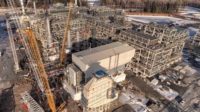Arizona Gas Plant's 575-MW Expansion Okayed After Scaleback Settlement

Photo: TC Energy
Arizona regulators have approved a pared-down proposal to expand the Salt River Project’s Coolidge natural gas power plant in Pinal County—following a court settlement with community opponents—which now reduces the number of new generation turbines to 12 from 16 and cuts the planned facility to 575 MW costing $775 million from an original 820-MW plan that was estimated to cost at least $830 million.
The revised expansion of the current 575-MW plant follows a settlement just reached between the Phoenix-area water and power utility and residents of Randolph, a historically minority community about 60 miles south that raised concerns about the more emissions from the enlarged facility. Their legal challenge last year, joined by environmental groups, prompted the Arizona Corporation Commission to reject the expansion plan, halting work.
The county has recorded among the highest air pollution readings in the state, according to American Lung Association and U.S. Environmental Protection Agency statistics that opponents cited.
The settlement, which comes as a utility court challenge to the regulator's rejection still is pending, boosts the project community benefits package from $11 million to $23 million, requires the facility to be sited 400 ft farther from residents and adds new capacity use limits.
The project's original EPC contract for the 820-MW plant expansion was awarded to WSP and TIC – The Industrial Co., a Denver-based unit of Kiewit Corp.. the team that completed the original plant in 2011. A TIC spokeswoman said no contractor has been confirmed and announced for the pared-down project.
The existing plant was built for TransCanada Pipelines Ltd, renamed in 2019 as TC Energy, and was bought by Salt River Project in 2019.
Renewables To be Integrated
The expansion project would boost utility flexibility in meeting power needs of the fast-growing area—including integrating solar, wind and battery storage, said Bobby Olsen, Salt River Project associate general manager and chief planning executive. Without the Coolidge plant enlargement, "power reliability is at risk starting in the summer of 2024,” says the utility website.
Olsen said Salt River Project plans to add 2,025 MW of solar and wind and 1,100 MW of battery storage by 2025, projecting that by then, more than 75% of customer power would be carbon free. But noting "increased variability in [renewables] power output" at certain times and under certain conditions, the utility said the gas plant expansion would "add quick-starting and fast-ramping power generation resources that can smooth out these fluctuations."
It added that building battery storage "over the next three years in the amounts required to achieve similar reliability as the proposed Coolidge expansion gives us pause." The utility said battery construction "at a measured pace allows us to gain operational experience as the technology evolves," with potential storage duration boosts and cost decreases eyed.
The project will be located on 100 acres near the existing facility, but its move to accommodate the community settlement will require a new design to balance plant systems, Salt River Project said.
The utility approved the original 820-MW expansion plan in 2021 to meet increasing peak demand. The peaking units are GE aero-derivative gas turbines able to ramp up to full production in 10 minutes. The project also requires construction of a new 500kV switchyard and new wastewater ponds.
The Sierra Club still opposes the project, claiming its proposed substantial changes require new commission review “so all parties can understand the revised project’s impacts” and regulators can determine if the utility needs the plant and if it is in the public interest.
Sandy Bahr, director of the group’s Grand Canyon chapter, said the new approval expansion is a blow to communities that trust regulators to act in their benefit.





